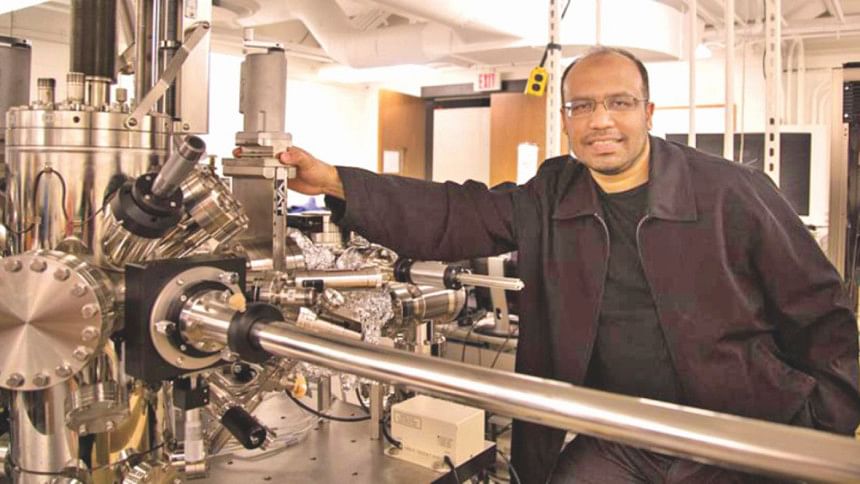Revolutionising electronics

It is said that Newton formulated the laws of motion by observing an apple that had fallen from a tree. It now appears that another apple is falling again. A recent discovery of a massless particle, called Weyl fermion, by an international research team led by Bangladeshi scientist Prof. M. Zahid Hasan of Princeton University may revolutionise electronics and may make computers and communications much faster and more efficient. The team included numerous researchers from Princeton's Department of Physics, including graduate students Ilya Belopolski and Daniel Sanchez, a post-doctoral research associate Guang Bian and associate research scholar Hao Zheng. The discovery was reported in a paper published online by Science on July 16.
The existence of the particle was predicted in 1929 by German mathematician and physicist Hermann Weyl who was a colleague of Albert Einstein at the Institute for Advanced Study at Princeton University. The particle remained elusive for 85 years. "The hunt for the Weyl fermion began in the earliest days of quantum theory when physicists first realised that their equations implied the existence of antimatter counterparts to commonly known particles such as electrons," Hasan said. "People figured that although Weyl's theory was not applicable to relativity or neutrinos, it is the most basic form of fermion and had all other kinds of weird and beautiful properties that could be useful," he said. "After more than 80 years, we found that this fermion was already there, waiting. It is the most basic building block of all electrons….It is exciting that we could finally make it come out following Weyl's 1929 theoretical recipe." He added. We do not know if he and his team shouted, "Eureka! Eureka!"
The researchers used an asymmetrical tantalum arsenide, a synthetic metallic crystal that was cooled at near absolute zero temperature and tested with high-energy accelerator-based photon beams at the Lawrence Berkeley National Laboratory in California. "Once fired through the crystal, the beams' shape, size and direction indicated the presence of the long-elusive Weyl fermion." The synthetic crystal was designed by the team in collaboration with researchers at the Collaborative Innovation Center of Quantum Matter in Beijing and at the National Taiwan University.
Present day electronics is based on the movement of electrons which are tiny, negatively charged subatomic particles. An electron is so small that it has a mass that is about 1/1836 of that of a proton, another subatomic particle that is positively charged. A proton is also a small particle - so small that about 1.673 billion billion billion protons together will have a mass of 1 kg! This comparison gives an idea about the mass of an electron. Even with its tiny mass, an electron is scattered by collision with other particles during movement. The researchers found that "Weyl fermions can be used to create massless electrons that move very quickly with no backscattering, wherein electrons are lost when they collide with an obstruction. In electronics, backscattering hinders efficiency and generates heat. Weyl electrons simply move through and around roadblocks," Hasan said. "It's like they have their own GPS and steer themselves without scattering…. They will move and move only in one direction… and never come to an end because they just tunnel through. These are very fast electrons that behave like unidirectional light beams and can be used for new types of quantum computing," he added.
Hasan has also added that the physics of the Weyl fermion is so "strange" that there could be many things that arise from this particle that is beyond our imagination. According to the theory of relativity, no particle with any mass can reach the speed of light. Weyl fermions being massless are not likely to be bound by Einstein's theory of relativity. Weyl, therefore, suggested his fermion as an alternative to Albert Einstein's theory of relativity.
It is postulated that future electronics may be based on Weyl fermions instead of present day electrons. I wonder if the term electronics will also change to fermionics! The unobstructed free movement of Weyl fermions will make computers and communications much faster and more efficient.
Ashvin Vishwanath, a professor of physics at the University of California-Berkeley who was not involved in the study, commented that even though it might be too early to understand the "practical implications" of this discovery, it should be noted that "Weyl materials are direct 3-D electronic analogs of graphene, which is being seriously studied for potential applications."
The world's scientific community is very excited about the recent discovery of Prof M. Zahid Hasan and his team. Hasan was a brilliant student and had his early schooling in Bangladesh. He completed an MS from Stanford University in 2000 and a Ph.D. from Princeton University in 2002. Over a 100 papers written by him have been published in respectable journals, including over 40 papers in Nature, Science and Physical Review, and earned numerous awards. Nobody should be surprised if his recent discovery earns him the Nobel Prize in Physics in the near future.
As Bangladeshis, we are extremely proud of him.
The writer is a retired nuclear engineer and
Dr. Rashid Professor of Bangladesh University of Engineering and Technology (BUET).

 For all latest news, follow The Daily Star's Google News channel.
For all latest news, follow The Daily Star's Google News channel. 



Comments